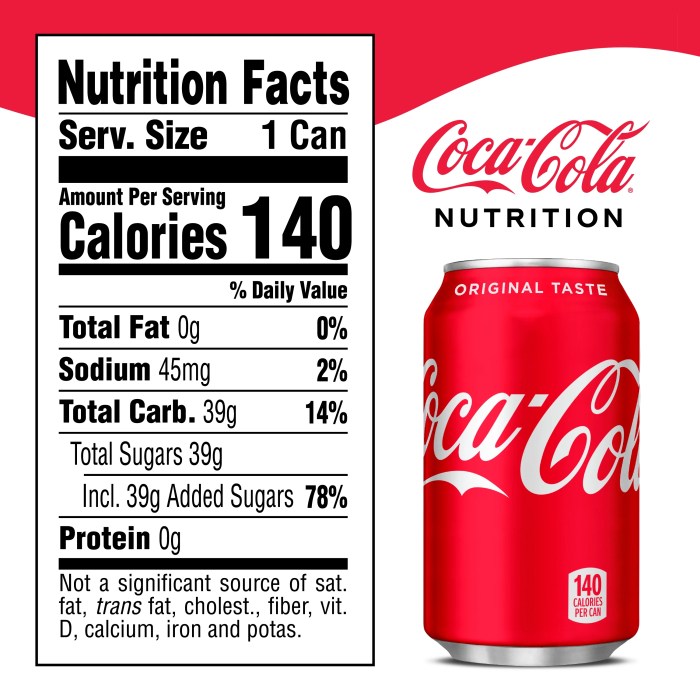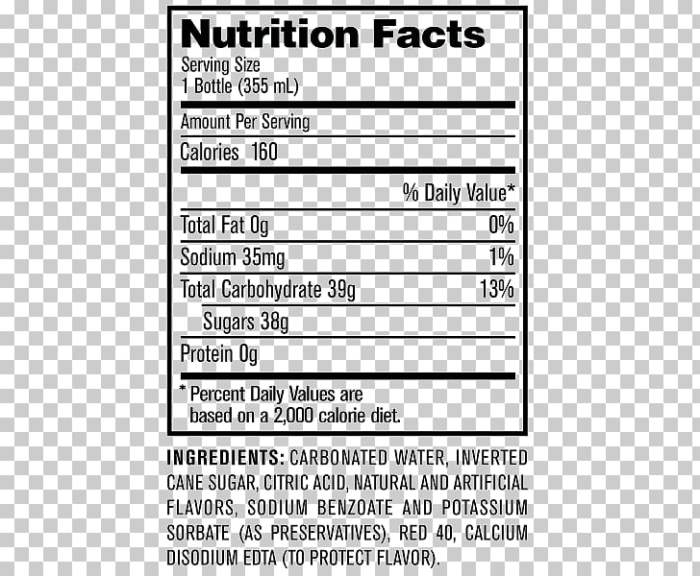Understanding the Nutritional Content of Soda

Nutrition facts label for soda – Deciphering the nutritional information on a soda label can be surprisingly revealing, impacting your understanding of the beverage’s impact on your health and well-being. Knowing what to look for and how to interpret the data empowers you to make informed choices about your consumption.
Soda’s nutrition facts label typically includes several key components. These usually list the serving size, total calories, total fat, saturated fat, trans fat, cholesterol, sodium, total carbohydrate, dietary fiber, total sugars, added sugars, and protein per serving. Understanding these components allows you to assess the nutritional profile of the soda and compare it to other beverages or foods.
Serving Size and its Significance
The serving size is crucial for accurately interpreting the nutritional information. The values listed on the label represent the amounts in a single serving, not the entire bottle or can. For example, a 20-ounce bottle of soda might be considered two or more servings, meaning you would need to multiply the values on the label accordingly to understand the total nutritional intake from consuming the whole bottle.
Ignoring the serving size can lead to a significant underestimation of your actual calorie and sugar intake.
Nutritional Differences Across Soda Types
Different types of soda possess vastly different nutritional profiles. Cola sodas are generally high in sugar and calories, often containing significant amounts of added sugars that contribute to empty calories. Diet sodas, on the other hand, typically have significantly fewer calories and sugars, often using artificial sweeteners instead. However, the long-term health effects of artificial sweeteners remain a subject of ongoing research.
Fruit-flavored sodas often contain added sugars and may or may not contain real fruit juice, varying considerably in their nutritional composition depending on the brand and specific recipe. For instance, a fruit-flavored soda with real fruit juice will likely have a slightly different nutritional profile than one that relies entirely on artificial flavors and added sugars.
Sugar Content Comparison Across Soda Brands
Sugar content varies considerably across different soda brands and types. While precise figures depend on the specific product and serving size, a general comparison might show that a typical 12-ounce can of cola soda from Brand A contains around 39 grams of sugar, while a similar-sized can of a fruit-flavored soda from Brand B might contain 35 grams, and a diet version from Brand C might contain less than 1 gram.
These differences highlight the importance of checking the nutrition facts label before consuming any soda, allowing for a more informed decision based on your personal dietary goals and preferences. Always refer to the individual product labels for the most accurate and up-to-date nutritional information.
Comparing Soda to Healthier Alternatives

Making the switch to healthier beverages can significantly improve your overall well-being. Let’s explore how soda stacks up against better hydration choices, highlighting the considerable nutritional differences and long-term benefits of choosing wisely. Understanding these differences can empower you to make informed decisions about your daily drinks.
Soda is often loaded with sugar, artificial sweeteners, and empty calories, offering little nutritional value. In contrast, healthier alternatives like water, unsweetened tea, and even 100% fruit juice (in moderation) provide essential nutrients and hydration without the negative consequences associated with excessive sugar intake.
Nutritional Comparison of Beverages
The following table clearly illustrates the stark contrast in nutritional profiles between soda and healthier beverage options. Consider a typical 12-ounce serving size for comparison.
| Beverage | Calories | Sugar (grams) | Other Nutrients |
|---|---|---|---|
| Soda (Regular) | 150-170 | 39-40 | Minimal to none |
| Water | 0 | 0 | Essential for bodily functions |
| Unsweetened Tea | 0-5 | 0 | Antioxidants (depending on tea type) |
| 100% Orange Juice (12oz) | 110-120 | 21-26 | Vitamin C, Potassium |
Weekly Caloric Intake Comparison
The cumulative effect of choosing soda over healthier alternatives becomes even more apparent when considering weekly consumption. Let’s assume a person drinks three 12-ounce sodas daily.
Over a week, this translates to approximately 3150-3570 calories from soda alone (3 sodas/day
– 7 days/week
– 150-170 calories/soda). Replacing these with water or unsweetened tea would drastically reduce this caloric intake to zero or near zero, potentially aiding in weight management and preventing health issues linked to excessive sugar consumption. For instance, switching to 100% orange juice would still reduce the weekly caloric intake significantly.
Benefits of Replacing Soda with Healthier Options, Nutrition facts label for soda
The advantages of substituting soda with healthier hydration options extend far beyond calorie reduction. These benefits include improved hydration, better weight management, reduced risk of chronic diseases like type 2 diabetes and heart disease, improved dental health (less tooth decay), and increased energy levels. Switching from soda to water, for example, will improve your overall health considerably, as it will contribute to better bodily functions and improved overall wellness.
Deciphering the often-confusing landscape of soda nutrition facts labels requires a keen eye. Understanding the caloric content, sugar rush, and other additives is crucial for informed choices. For example, a quick glance at the mtn dew zero nutrition facts reveals the impact of artificial sweeteners on the overall nutritional profile. Ultimately, comparing these labels helps consumers make healthier beverage selections.
Visual Representation of Nutritional Information

A clear and concise visual representation of a soda’s nutrition facts is crucial for consumers to quickly grasp its nutritional profile and make informed choices. Effective design utilizes color, font size, and strategic placement to emphasize key aspects, ultimately empowering consumers to understand the impact of their beverage choices on their health.Visual representations significantly improve understanding by transforming complex numerical data into easily digestible information.
Instead of relying solely on reading and interpreting numbers, a well-designed label allows consumers to instantly perceive the relative proportions of different nutrients, leading to quicker and more accurate assessments.
Color-Coding and Font Sizes for Enhanced Clarity
The visual representation should employ a strategic color scheme to highlight critical information. For example, the amount of sugar could be represented by a bar graph, with the bar colored a distinct shade of red to visually emphasize its high content. In contrast, the amount of vitamins or minerals (if any) could be represented with a lighter, less prominent color.
Font sizes should also be used to emphasize key components. The serving size, calories, and total sugars should be displayed in a larger, bolder font size compared to less critical information such as sodium or potassium. This ensures that the most impactful information is immediately apparent to the consumer. For instance, a 12-ounce can of soda with 40 grams of sugar would have “40g Sugar” in a large, bold, red font, drawing immediate attention to the high sugar content.
Strategic Placement of Critical Information
The layout of the nutritional information should prioritize clarity. The most important information—serving size, calories, and total sugars—should be placed prominently at the top of the label, immediately catching the eye. Secondary information, such as saturated fat and sodium content, can be placed below. Using a clear, uncluttered layout, with ample white space between elements, ensures that the information is easy to read and understand.
A logical hierarchy of information, using size and color to create visual cues, makes the label more user-friendly. The nutritional information could be presented in a table format with clearly defined headers and rows, further enhancing readability.
Visual Cues for Communicating Sugar Content
To better communicate the sugar content of different sodas, visual cues beyond simple numerical values can be implemented. A visual comparison using a bar graph showing the sugar content of several sodas side-by-side would immediately reveal the differences in sugar levels. For example, a bar graph could compare a regular cola to a diet cola and a fruit-flavored sparkling water, clearly demonstrating the significant disparity in sugar content.
Another approach could involve using a color gradient, with darker shades of red representing higher sugar levels and lighter shades representing lower sugar levels. This provides an intuitive and immediate understanding of the relative sweetness of different soda options. The visual representation could also include a simple icon indicating the number of teaspoons of sugar present in a single serving, providing a relatable context for consumers.
Clarifying Questions: Nutrition Facts Label For Soda
What are the long-term effects of drinking diet soda?
While diet soda avoids sugar, the long-term effects of artificial sweeteners are still under research. Some studies suggest potential links to metabolic issues, but more research is needed to definitively conclude their impact on long-term health.
Are all sodas created equal in terms of sugar?
Absolutely not! Sugar content varies wildly between brands and types of soda. Colas generally have higher sugar content than other types, and even within cola, different brands have different levels of sugar.
How can I reduce my soda consumption gradually?
Start by slowly decreasing your daily intake. Replace one soda with water or unsweetened tea. Gradually increase the number of healthier alternatives as you feel comfortable. Find substitutes you enjoy to make the transition easier.
